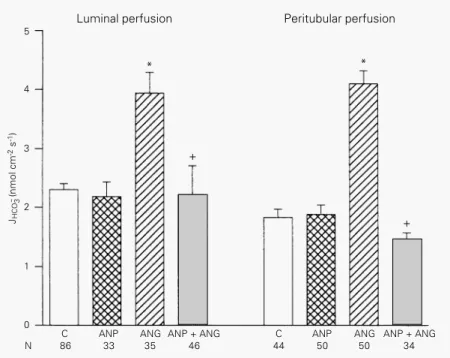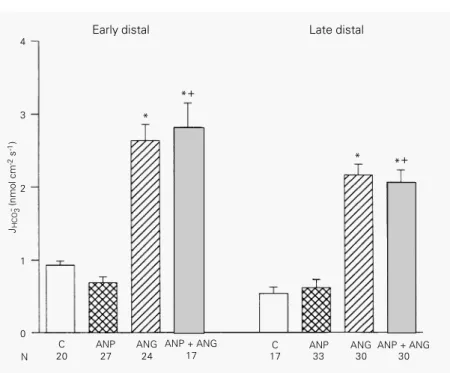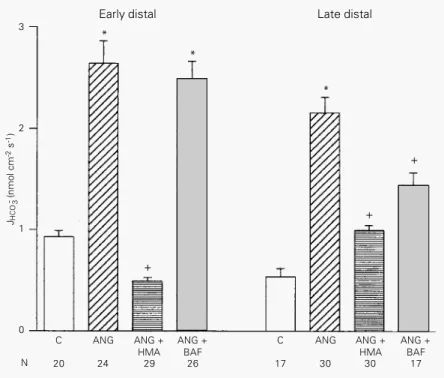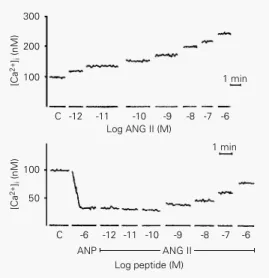Interactions of ANP and ANG II
in tubular nephron acidification
Departamento de Fisiologia e Biofísica, Instituto de Ciências Biomédicas, Universidade de São Paulo, 05508-900 São Paulo, SP, Brasil
M. Mello-Aires, M.L.M. Barreto-Chaves, G. Nascimento-Gomes and M. Oliveira-Souza
Abstract
In order to examine the effects and the interaction of angiotensin II (ANG II, 1 pM) and atrial natriuretic peptide (ANP, 1 µM) on the kinetics of bicarbonate reabsorption in the rat middle proximal tubule, we performed in vivo experiments using a stopped-flow microperfu-sion technique with the determination of lumen pH by Sb microelec-trodes. These studies confirmed that ANG II added to the luminal or peritubular capillary perfusion fluid stimulates proximal bicarbonate reabsorption and showed that ANP alone does not affect this process, but impairs the stimulation caused by ANG II. We also studied the effects and the interaction of these hormones in cortical distal nephron acidification. Bicarbonate reabsorption was evaluated by the acidifi-cation kinetic technique in early (ED) and late (LD) distal tubules in rats during in vivo stopped-flow microperfusion experiments. The intratubular pH was measured with a double-barreled microelectrode with H+-sensitive resin. The results indicate that ANG II acted by stimulating Na+/H+ exchange in ED (81%) and LD (54%) segments via activation of AT1 receptors, as well as vacuolar H+-ATPase in LD segments (33%). ANP did not affect bicarbonate reabsorption in either segment and, as opposed to what was seen in the proximal tubule, did not impair the stimulation caused by ANG II. To investigate the mechanism of action of these hormones in more detail, we studied cell pH dependence on ANG II and ANP in MDCK cells using the fluorescent probe BCECF. We showed that the velocity of cell pH recovery was almost abolished in the absence of Na+, indicating that it is dependent on Na+/H+ exchange. ANP (1 µM) alone had no effect on this recovery but reversed both the acceleration of H+ extrusion at low ANG II levels (1 pM and 1 nM), and inhibition of H+ extrusion at higher ANG II levels (100 nM). To obtain more information on the mechanism of interaction of these hormones, we also studied their effects on the regulation of intracellular free calcium concentration, [Ca2+]
i, monitored with the fluorescent probe Fura-2 in MDCK cells in suspension. The data indicate that the addition of increasing concen-trations of ANG II (1 pM to 1 µM) to the cell suspension led to a progressive increase in [Ca2+]
i to 2-3 times the basal level. In contrast, the addition of ANP (1 µM) to the cell suspension led to a very rapid 60% decrease in [Ca2+]
i and reduced the increase elicited by ANG II, thus modulating the effect of ANG II on [Ca2+]
i. These results may indicate a role of [Ca2+]
i in the regulation of the H+ extrusion process mediated by Na+/H+ exchange and stimulated/impaired by ANG II. The data are compatible with stimulation of Na+/H+ exchange by increases of [Ca2+]
i in the lower range, and inhibition at high [Ca2+]i levels.
Correspondence M. Mello-Aires
Departamento de Fisiologia e Biofísica
Instituto de Ciências Biomédicas Universidade de São Paulo 05508-900 São Paulo, SP Brasil
Fax: 55 (011) 818-7285
Presented at the International Symposium Neuroendocrine Control of Body Fluid Homeostasis, Ribeirão Preto, SP, Brasil, August 17-20, 1996.
Research supported by FAPESP, CNPq and FINEP.
Received November 29, 1996 Accepted January 6, 1997
Key words •Angiotensin II •ANP
•Bicarbonate reabsorption •Cell pH
The atrial natriuretic peptides (ANPs) are a family of peptides originating from mammalian heart atria which present strong natriuretic and diuretic properties. Several studies indicate that ANP acts directly on the kidney by enhancing the glomerular filtra-tion rate (GFR) (1-3). However, it remains unclear whether ANP has a direct effect on the proximal tubule or whether the observed diuresis and natriuresis are the result of an increased fluid flow along this nephron seg-ment caused by the increased GFR. Because
several of the studies were performed in vivo
and functional cholinergic receptors on the basolateral side of the proximal tubule can regulate bicarbonate reabsorption and fluid flux (4), systemic effects of ANP and the influence of the renal nerves may mask a direct action of ANP on the proximal neph-ron.
Angiotensin II (ANG II), an octapeptide naturally found in blood, is a potent regula-tor of acidification in the rat early proximal tubule (5). This hormone stimulates both
apical Na+/H+ exchange and basolateral Na+
-HCO3
cotransport in perfused S1 segments of proximal tubules isolated from superficial nephrons of the rabbit kidney (6). Electro-physiological studies of ANG II regulation
of Na+-HCO
3
- cotransport in isolated
per-fused S2 segments of rabbit renal proximal tubules confirmed that picomolar concentra-tions of ANG II stimulate (7), while micro-molar concentrations inhibit (8) basolateral
Na+-HCO
3
cotransport.
An interaction between ANP and ANG II has been observed in a variety of tissues. ANP inhibits the vasoconstrictor effect of
ANG II on blood vessels in vitro (9), as well
as the systemic pressor action of ANG II (10) and ANG II-stimulated aldosterone synthe-sis (11). Using the split-droplet technique, Harris et al. (12) found that ANP had an inhibitory effect on proximal fluid absorp-tion stimulated by preliminary ANG II per-fusion. Similar results were obtained by Garvin (13) in isolated perfused proximal straight tubules. However, the same effect was not observed by Liu and Cogan (14)
during in vivo free-flow micropuncture
ex-periments.
In order to examine the effects and the interaction of ANG II (1 pM) and ANP (1 µM) on the kinetics of bicarbonate reabsorp-tion in the middle proximal tubule of rats,
we performed in vivo experiments using a
stopped-flow microperfusion technique, which is not affected by GFR (15). In this preparation, the systemic effects of both hor-mones were eliminated during luminal or peritubular capillary perfusion, as confirmed by the absence of changes in urine flow and
Na+ excretion under these conditions.
Bicar-bonate reabsorption was measured by sta-tionary microperfusion and lumen pH was determined with Sb microelectrodes. Net
bicarbonate reabsorption (JHCO3-) was
ob-tained by the following relation:
JHCO3- = k([HCO
3
-]i - [HCO3
-]s) r/2
where k is the rate constant of the reduction Figure 1 - Effect of atrial natriuretic peptide (ANP, 1 µM) and/or angiotensin II (ANG, 1 pM)
on HCO3- reabsorption in proximal tubule. The experiments were performed in tubules undergoing luminal (left) or peritubular capillary (right) perfusions with the hormones. Data are reported as means ± SEM. N, Number of microperfusions; JHCO3- , net HCO
3 -
reabsorp-tion. *P<0.05 compared to control (C); +P<0.05 compared to ANG II (Bonferroni test).
JHCO
3
- (nmol cm -2 s -1)
ANP + ANG 34 ANG
50 5
4
3
2
1
0 C 86
ANP 33
ANG 35
ANP + ANG 46
C 44
ANP 50 *
+
+ *
Luminal perfusion Peritubular perfusion
of luminal bicarbonate [k = ln2/(t/2)], t/2 is the half-time of luminal bicarbonate
disap-pearance, r is the tubule radius, and [HCO3
-]i
and [HCO3
-]s are the concentrations of the
injected HCO3
and HCO3
at the stationary level, respectively.
Figure 1 shows some of the results ob-tained in this study. It was noted that ANP perfused in the lumen did not change proxi-mal bicarbonate reabsorption but inhibited the stimulation induced by luminal
perfu-sion of ANG II: JHCO3- was 2.30 ± 0.10 nmol
cm-2 s-1 (N = 86) with luminal control
perfu-sion, 2.18 ± 0.25 nmol cm-2 s-1 (N = 33)
during ANP luminal perfusion, increased to
3.94 ± 0.35 nmol cm-2 s-1 (N = 35) with ANG
II luminal perfusion and decreased to 2.21 ±
0.15 nmol cm-2 s-1 (N = 46) during ANG II
plus ANP luminal perfusion. The perfusion of ANP in the peritubular capillary also did not affect proximal bicarbonate reabsorp-tion but caused an inhibireabsorp-tion of the stimula-tory effect of ANG II in peritubular capillary
perfusion: JHCO3- was 1.83 ± 0.14 nmol cm-2
s-1 (N = 44) with peritubular capillary
con-trol perfusion, 1.88 ± 0.16 nmol cm-2 s-1
(N = 50) during ANP peritubular perfusion,
increased to 4.10 ± 0.22 nmol cm-2 s-1
(N = 50) during capillary perfusion with ANG II and decreased to 1.56 ± 0.11 nmol
cm-2 s-1 (N = 34) when ANG II plus ANP
were added to the peritubular perfusion. Therefore, these studies confirmed that ANG II stimulates proximal bicarbonate re-absorption and showed that ANP alone does not affect this process, but impairs the stim-ulation caused by ANG II.
We have recently studied the effects and interaction of these hormones also in corti-cal distal nephron acidification (16). Bicar-bonate reabsorption was evaluated by the acidification kinetic technique in early (ED)
and late (LD) distal tubules in rats during in
vivo stopped-flow microperfusion
experi-ments. The intratubular pH was measured with a double-barreled microelectrode with
one barrel filled with H+-sensitive resin and
the other with 1 M KCl (17).
Figure 2 shows a significant increase in
HCO3
reabsorption in the presence of lumi-nal ANG II (1 pM) both in ED (from 0.93 ±
0.06, N = 20, to 2.64 ± 0.21 nmol cm-2 s-1, N
= 24) and LD segments (from 0.542 ± 0.086,
N = 17, to 2.16 ± 0.151 nmol cm-2 s-1, N =
30). ANP (1 µM) alone did not affect bicar-bonate reabsorption in either the ED or LD segment nor did it impair the stimulation caused by ANG II.
The addition of the AT1 receptor
antago-nist losartan (1µM) to luminal perfusion
blocked luminal ANG II-mediated stimula-tion in ED and LD segments.
We also examined the specific mecha-nisms by which luminal ANG II stimulates
bicarbonate reabsorption.Figure 3
summa-rizes the results obtained in ED and LD segments during luminal perfusion with ANG II plus hexamethylene-amiloride (HMA, 100
µM, a specific blocker of Na+/H+ exchange)
or with ANG II plus bafilomycin A1 (200
JHCO
3
- (nmol cm -2 s -1)
ANP + ANG 30 ANG
30 4
3
2
1
0 C 20
ANP 27
ANG 24
ANP + ANG 17
C 17
ANP 33 *
Early distal Late distal
* *+
Figure 2 - Effect of atrial natriuretic peptide (ANP, 1 µM) and/or angiotensin II (ANG, 1 pM) on HCO- 3reabsorption in early (left) and late (right) distal tubules. The experiments were performed in tubules undergoing luminal perfusions with the hormones. Data are reported as means ± SEM. N, Number of microperfusions; JHCO3-, net HCO
3 -
reabsorption. *P<0.05 compared to control (C); +P<0.05 compared to ANP (Bonferroni test).
N
dp Hi
/dt
10 7
0.2
0.1
0.0
14 13 7 6 7
*
Angiotensin
12
5 4
C
1 pM 1 nM 100 nM
5
ANP = 1 µM Na+ = 0 mM
*
+ +
+ +
+
*
JHCO
3
- (nmol cm -2 s -1)
ANG + BAF
17 ANG +
HMA 30 3
2
1
0 C
20 ANG
24
ANG + HMA
29
ANG + BAF
26
C
17
ANG
30 *
+
Early distal Late distal
*
*
+ + Figure 3 - Effect of luminal
an-giotensin II (ANG, 1 pM) plus HMA (100 µM) or bafilomycin A1 (BAF, 200 nM) on HCO3- reab-sorption. The experiments were performed in early (left) and late (right) distal tubules. Data are re-ported as means ± SEM. N, Number of microperfusions; JHCO3- , net HCO
3 -
reabsorption. *P<0.05 compared to control (C); +P<0.05 compared to ANG II (Bonferroni test).
Figure 4 - Velocity of pH recov-ery (dpHi/dt) in MDCK cells sub-jected to increasing angiotensin II concentrations (1 pM, 1 nM and 100 nM) alone or in the presence of atrial natriuretic pep-tide (ANP, 1 µM). The experi-ments were done in the pres-ence (145 mM) or abspres-ence of Na+. *P<0.05 compared to con-trol (C); +P<0.05 compared to ANG II (Bonferroni test).
N
[Ca
2+
]i
(nM)
300
200
100
100
50
[Ca
2+
]i
(nM)
C -12 -11 -10 -9 -8 -7 -6
C -12 -11 -10 -9 -8 -7 -6
-6
Log ANG II (M)
1 min
1 min
ANP ANG II
Log peptide (M)
Figure 5 - Cell calcium levels in MDCK cells subjected to in-creasing angiotensin II (ANG II) concentrations (upper panel) alone or in the presence of atrial natriuretic peptide (ANP, 1 µM; lower panel). Data from Ref. 20, with permission.
nM, a highly specific inhibitor of vacuolar
H+-ATPase). HMA inhibited the stimulation
of bicarbonate reabsorption induced by ANG
II in ED (JHCO3- decreased to 0.497 ± 0.035
nmol cm-2 s-1, N = 29) and LD segments
(JHCO3- decreased to 0.998 ± 0.047 nmol
cm-2 s-1, N = 30). Bafilomycin A1 did not
inhibit the stimulation of ED bicarbonate
reabsorption induced by ANG II (JHCO3
-was 2.50 ± 0.172 nmol cm-2 s-1, N = 26);
however, in LD segments JHCO3- was
signifi-cantly decreased to 1.45 ± 0.139 nmol cm-2
s-1 (N = 17).
In conclusion, these results indicate that
ANG II acts by stimulating Na+/H+ exchange
in ED (81% of the ANG II-stimulated rate) and LD (54%) segments via activation of
AT1 receptors, as well as vacuolar H+-ATPase
in LD segments (33%). ANP does not affect bicarbonate reabsorption in either segment and, as opposed to what was seen in the proximal tubule, does not impair the stimu-lation caused by ANG II. This result is in accordance with data indicating that in ED segments bicarbonate reabsorption is
medi-ated predominantly by Na+/H+ exchange and
in LD segments by vacuolar H+-ATPase
(17,18) and with studies that indicate the absence of ANP receptors in distal segments (19). The present study, however, does not allow us to ascribe the results with ANG II to any specific cell type that might contribute to acidification in cortical distal tubules.
In order to investigate the mechanism of action of these hormones in more detail, we studied the dependence of cell pH on ANG II and ANP in MDCK cells, a permanent cell line derived from dog kidneys, with some properties of distal nephron epithelia. Cells were grown to confluence on coverslips, and cytosolic pH was determined with the fluo-rescent probe BCECF in spectrofluorimeter cuvettes. The cells were acid loaded using
the NH4Cl pre-pulse technique, and the rate
of cell pH recovery was followed with con-trol or hormone-containing solutions.
Some of the results obtained in these
studies are illustrated in Figure 4. The veloc-ity of cell pH recovery (dpH/dt) was almost
abolished in the absence of Na+, indicating
that it is dependent on Na+/H+ exchange.
This recovery was markedly increased when ANG II was used at concentrations from 1 pM to 1 nM. On the other hand, when con-centrations of 100 nM ANG II were used this recovery rate was significantly reduced. We also showed that ANP (1 µM) alone had no effect on this recovery but reversed both the
acceleration of H+ extrusion at low ANG II
levels and inhibition of H+ extrusion at higher
ANG II levels.
To obtain more information on the mech-anism of interaction of these hormones, we also studied their effects on the regulation of intracellular free calcium concentration,
[Ca2+]
i, monitored with the fluorescent probe
Fura-2 in MDCK cells in suspension (20).
The results are shown in Figure 5. [Ca2+]
i
increased progressively from control values of 100 nM to approximately 250 nM when ANG II concentration in the cell suspension increased from 1 pM to 1 µM. On the other hand, when 1 µM ANP was added to the cell
suspension, [Ca2+]
i decreased from control
values to 35 nM. The addition of ANG II (1 pM-1 µM) in the presence of ANP
in-creased [Ca2+]
i, but without exceeding
nor-mal control values. These results may
indi-cate a role of [Ca2+]
process of H+ extrusion mediated by Na+/H+
exchange and stimulated/impaired by ANG II. The data are compatible with stimulation
of Na+/H+ exchange by increases of [Ca2+]
i in
the lower range, and inhibition at high [Ca2+]
i
levels.
At lower levels of ANG II (1 pM-1 nM),
the increase in [Ca2+]
i may be mediated by
AT1B ANG II receptors which activate
phos-pholipase C, causing the stimulation of ino-sitol triphosphate and diacylglycerol, which
elevate [Ca2+]
i by releasing it from cell stores.
Calcium activates protein kinase C which,
via phosphorylation, may stimulate the Na+/
H+ exchanger (21). Another possible
mech-anism of action of low-dose ANG II is a signalling pathway involving the activation of an inhibitory G protein and inhibition of adenosylate cyclase, causing a decrease in cAMP levels and in the catalytic activity of protein kinase A, a reduction which causes
the activation of Na+/H+ exchange (22). On
the other hand, ANP has been shown to block the activity of phospholipase C, thus impairing the pathway causing the increase in cell calcium (23).
At high levels (100 nM) ANG II interacts
with AT1A receptors, causing the liberation
of arachidonic acid, which is part of a
path-way that elevates [Ca2+]
i by activating
volt-age-sensitive calcium channels in the plasma membrane (21). At high cytosolic
concen-trations, calcium may inhibit Na+/H+
ex-change by activating Na+/Ca2+ exchange at
the cell membrane level, thereby increasing cell sodium, which in turn decreases the
gradient responsible for H+ extrusion by the
exchanger. However, this mechanism is somewhat questionable considering the large discrepancy between cytosolic calcium and extracellular sodium concentrations.
On the other hand, it has been shown that the NHE1 exchanger has calmodulin-bind-ing sites at the cytoplasmic regulatory do-main, which modulate its activity. A high-affinity site, which is tonically inhibitory, binds to low calcium/calmodulin suppress-ing the inhibition, i.e., stimulatsuppress-ing the
ex-changer at low cell Ca2+/calmodulin levels.
A low-affinity site, however, binds to cal-cium and calmodulin only at high concentra-tions, and under these conditions inhibits the exchanger activity (24). This behavior is compatible with our findings about the ANG II-ANP interaction in proximal nephron and MDCK cells.
References
1. Beasley D & Malvin RL (1985). Atrial ex-tracts increase glomerular filtration rate in vivo. American Journal of Physiology, 248 (Renal, Fluid and Electrolyte Physiology, 17): F24-F30.
2. Cogan MG (1986). Atrial natriuretic factor can increase renal solute excretion prima-rily by raising glomerular filtration. Ameri-can Journal of Physiology, 250 (Renal, Fluid and Electrolyte Physiology, 19): F710-F715.
3. Sosa RE, Volpe M, Marion J, Vaughan ED, Atlas SA, Laragh JH & Maack T (1986). Relationship between renal hemodynam-ics and natriuretic effects of atrial natri-uretic factor. American Journal of Physiol-ogy, 250 (Renal, Fluid and Electrolyte Physiology, 19): F520-F524.
4. Wang T & Chan YL (1990). Cholinergic effect on rat proximal convoluted tubule. PflügersArchiv, 415: 533-539.
5. Liu FY & Cogan MG (1987). Angiotensin II: a potent regulator of acidification in the rat early proximal convoluted tubule. Jour-nal of Clinical Investigation,80: 272-275. 6. Geibel J, Giebisch G & Boron WF (1990). Angiotensin II stimulates both Na+/H+ ex-change and Na+/HCO
3
- cotransport in the
rabbit proximal tubule. Proceedings of the National Academy of Sciences, USA, 87: 7917-7920.
7. Coppola S & Frömter E (1994). An elec-trophysiological study of angiotensin II regulation of Na+-HCO
3 -
cotransport and K+ conductance in renal proximal tubules. I. Effect of picomolar concentrations. PflügersArchiv, 427: 143-150.
8. Coppola S & Frömter E (1994). An elec-trophysiological study of angiotensin II regulation of Na+-HCO
3 -
cotransport and K+ conductance in renal proximal tubules. II. Effect of micromolar concentrations. PflügersArchiv, 427: 151-156.
9. Kleinert HD, Maack T, Atlas SA, Januszewicz A, Sealey JE & Laragh JH (1984). Atrial natriuretic factor inhibits an-giotensin-, norepinephrine-, and potas-sium-induced vascular contractility. Hy-pertension, 6 (Suppl I): I.143-I.147. 10. Di Nicolantonio R, Stevens J, Weaver D &
Morgan TO (1986). Captopril antagonizes the hypotensive action of atrial natriuretic peptide in anaesthetized rat. Clinical and Experimental Pharmacology and Physiol-ogy, 13: 311-314.
11. Atarashi K, Mulrow PJ, Franco-Saenz R, Snajdar R & Rapp J (1984). Inhibition of aldosterone production by an atrial ex-tract. Science, 224: 992-994.
13. Garvin JL (1989). Inhibition of Jv by ANF in rat proximal straight tubules requires an-giotensin. American Journal of Physiolo-gy, 257 (Renal, Fluid and Electrolyte Phys-iology, 26): F907-F911.
14. Liu FY & Cogan MG (1988). Atrial natri-uretic factor does not inhibit basal or an-giotensin II-stimulated proximal transport. American Journal of Physiology, 255 ( Re-nal, Fluid and Electrolyte Physiology, 24): F434-F437.
15. Nascimento-Gomes G & Mello-Aires M (1992). Interaction of atrial natriuretic fac-tor and angiotensin II in proximal HCO-3 reabsorption. American Journal of Physi-ology, 262 (Renal, Fluid and Electrolyte Physiology, 31): F303-F308.
16. Barreto-Chaves MLM & Mello-Aires M (1996). Effect of luminal angiotensin II and ANP on early and late cortical distal tubule HCO3- reabsorption. American Journal of
Physiology, 40: F977-F984.
17. Fernandez R, Lopes MJ, De Lira RF, Dantas WFG, Cragoe JR & Malnic G (1994). Mechanism of acidification along cortical distal tubule of the rat. American Journal of Physiology, 266 (Renal, Fluid and Electrolyte Physiology, 35): F218-F226.
18. Wang T, Malnic G, Giebisch G & Chan YL (1993). Renal bicarbonate reabsorption in the rat. IV. Bicarbonate transport mecha-nisms in the early and late distal tubule. Journal of Clinical Investigation, 91: 2776-2784.
19. Maack T (1992). Receptors of atrial natri-uretic factor. Annual Review of Physiolo-gy,54: 11-27.
20. Nascimento-Gomes G, Souza MO, Vecchia MG, Oshiro MEM, Ferreira AT & Mello Aires M (1995). Atrial natriuretic peptide modulates the effect of angio-tensin II on the concentration of free cal-cium in the cytosol of Madin-Darby canine kidney cells. Brazilian Journal of Medical and Biological Research, 28: 609-613.
21. Douglas JG & Hopfer U (1994). Novel as-pect of angiotensin receptors and signal transduction in the kidney. Annual Review of Physiology, 56: 649-669.
22. Pouyssegur J (1994). Molecular biology and hormonal regulation of vertebrate Na+/H+ exchanger isoforms. Renal
Physi-ology and Biochemistry, 17: 190-193. 23. Brenner BM, Ballermann BJ, Gunning ME
& Zeidel ML (1990). Diverse biological ac-tions of atrial natriuretic peptide. Physi-ologicalReviews, 70: 665-700.



